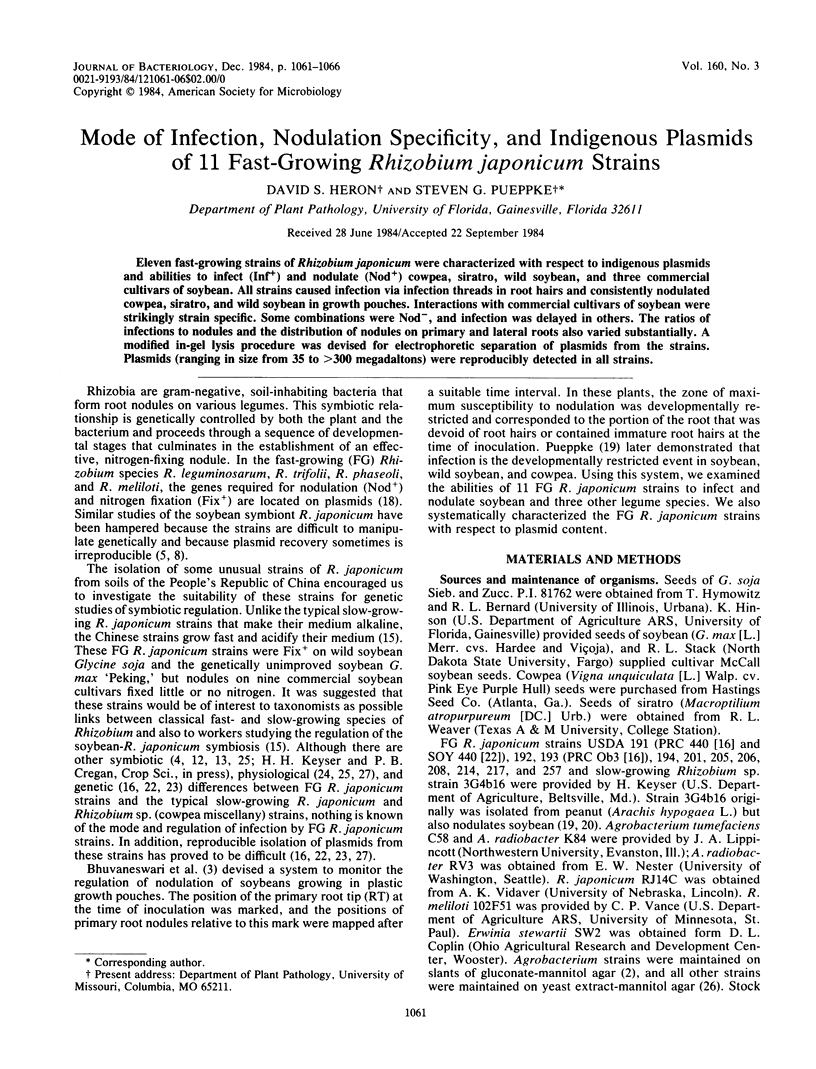Abstract
Eleven fast-growing strains of Rhizobium japonicum were characterized with respect to indigenous plasmids and abilities to infect (Inf+) and nodulate (Nod+) cowpea, siratro, wild soybean, and three commercial cultivars of soybean. All strains caused infection via infection threads in root hairs and consistently nodulated cowpea, siratro, and wild soybean in growth pouches. Interactions with commercial cultivars of soybean were strikingly strain specific. Some combinations were Nod-, and infection was delayed in others. The ratios of infections to nodules and the distribution of nodules on primary and lateral roots also varied substantially. A modified in-gel lysis procedure was devised for electrophoretic separation of plasmids from the strains. Plasmids (ranging in size from 35 to greater than 300 megadaltons) were reproducibly detected in all strains.
Full text
PDF





Images in this article
Selected References
These references are in PubMed. This may not be the complete list of references from this article.
- Bhuvaneswari T. V., Mills K. K., Crist D. K., Evans W. R., Bauer W. D. Effects of culture age on symbiotic infectivity of Rhizobium japonicum. J Bacteriol. 1983 Jan;153(1):443–451. doi: 10.1128/jb.153.1.443-451.1983. [DOI] [PMC free article] [PubMed] [Google Scholar]
- Bhuvaneswari T. V., Pueppke S. G., Bauer W. D. Role of lectins in plant-microorganism interactions: I. Binding of soybean lectin to rhizobia. Plant Physiol. 1977 Oct;60(4):486–491. doi: 10.1104/pp.60.4.486. [DOI] [PMC free article] [PubMed] [Google Scholar]
- Bhuvaneswari T. V., Turgeon B. G., Bauer W. D. Early Events in the Infection of Soybean (Glycine max L. Merr) by Rhizobium japonicum: I. LOCALIZATION OF INFECTIBLE ROOT CELLS. Plant Physiol. 1980 Dec;66(6):1027–1031. doi: 10.1104/pp.66.6.1027. [DOI] [PMC free article] [PubMed] [Google Scholar]
- Broughton W. J., Heycke N., Z A H. M., Pankhurst C. E. Plasmid-linked nif and "nod" genes in fast-growing rhizobia that nodulate Glycine max, Psophocarpus tetragonolobus, and Vigna unguiculata. Proc Natl Acad Sci U S A. 1984 May;81(10):3093–3097. doi: 10.1073/pnas.81.10.3093. [DOI] [PMC free article] [PubMed] [Google Scholar]
- Coplin D. L., Rowan R. G., Chisholm D. A., Whitmoyer R. E. Characterization of plasmids in Erwinia stewartii. Appl Environ Microbiol. 1981 Oct;42(4):599–604. doi: 10.1128/aem.42.4.599-604.1981. [DOI] [PMC free article] [PubMed] [Google Scholar]
- Eckhardt T. A rapid method for the identification of plasmid desoxyribonucleic acid in bacteria. Plasmid. 1978 Sep;1(4):584–588. doi: 10.1016/0147-619x(78)90016-1. [DOI] [PubMed] [Google Scholar]
- Halverson L. J., Stacey G. Host recognition in the Rhizobium-soybean symbiosis: detection of a protein factor in soybean root exudate which is involved in the nodulation process. Plant Physiol. 1984 Jan;74(1):84–89. doi: 10.1104/pp.74.1.84. [DOI] [PMC free article] [PubMed] [Google Scholar]
- Hattori J., Johnson D. A. Fast-Growing Rhizobium japonicum That Effectively Nodulates Several Commercial Glycine max L. Merrill Cultivars. Appl Environ Microbiol. 1984 Jul;48(1):234–235. doi: 10.1128/aem.48.1.234-235.1984. [DOI] [PMC free article] [PubMed] [Google Scholar]
- Kado C. I., Liu S. T. Rapid procedure for detection and isolation of large and small plasmids. J Bacteriol. 1981 Mar;145(3):1365–1373. doi: 10.1128/jb.145.3.1365-1373.1981. [DOI] [PMC free article] [PubMed] [Google Scholar]
- Keyser H. H., Bohlool B. B., Hu T. S., Weber D. F. Fast-growing rhizobia isolated from root nodules of soybean. Science. 1982 Mar 26;215(4540):1631–1632. doi: 10.1126/science.215.4540.1631. [DOI] [PubMed] [Google Scholar]
- Masterson R. V., Russell P. R., Atherly A. G. Nitrogen fixation (nif) genes and large plasmids of Rhizobium japonicum. J Bacteriol. 1982 Nov;152(2):928–931. doi: 10.1128/jb.152.2.928-931.1982. [DOI] [PMC free article] [PubMed] [Google Scholar]
- Merlo D. J., Nester E. W. Plasmids in avirulent strains of Agrobacterium. J Bacteriol. 1977 Jan;129(1):76–80. doi: 10.1128/jb.129.1.76-80.1977. [DOI] [PMC free article] [PubMed] [Google Scholar]
- Pueppke S. G., Freund T. G., Schulz B. C., Friedman H. P. Interaction of lectins from soybean and peanut with rhizobia that nodulate soybean, peanut, or both plants. Can J Microbiol. 1980 Dec;26(12):1489–1497. doi: 10.1139/m80-246. [DOI] [PubMed] [Google Scholar]
- Rosenberg C., Casse-Delbart F., Dusha I., David M., Boucher C. Megaplasmids in the plant-associated bacteria Rhizobium meliloti and Pseudomonas solanacearum. J Bacteriol. 1982 Apr;150(1):402–406. doi: 10.1128/jb.150.1.402-406.1982. [DOI] [PMC free article] [PubMed] [Google Scholar]
- Sadowsky M. J., Bohlool B. B. Possible involvement of a megaplasmid in nodulation of soybeans by fast-growing rhizobia from china. Appl Environ Microbiol. 1983 Oct;46(4):906–911. doi: 10.1128/aem.46.4.906-911.1983. [DOI] [PMC free article] [PubMed] [Google Scholar]




